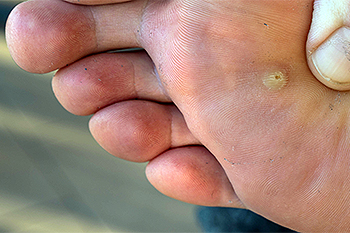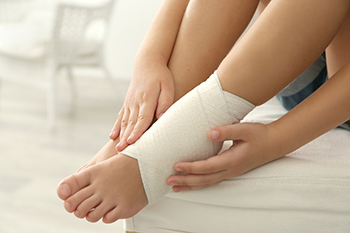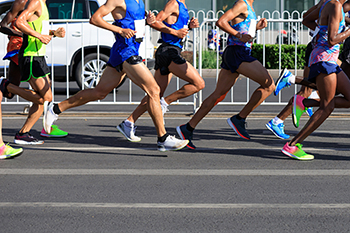Items filtered by date: July 2022
Common Environments Where Falls Can Happen

Nursing care centers often have their staff take a course in how to prevent residents from falling. It is a common occurrence that can happen in nursing care centers, hospitals, or homes, and it can inflict serious damage to the body and feet. This can make patients afraid of falling, causing them to limit their daily activities. There are conditions that contribute to falling episodes, and these can include body weakness, vision and physical illness, and walking and maintaining balance may be difficult. Some people may be deficient in vitamin D, and may possibly take medications consisting of tranquilizers and sedatives which may increase the risk of falling. There are simple fall prevention methods that can be implemented in the home, which may help to prevent falling. These can include removing worn rugs, and improving lighting in the house. It is beneficial to have a grab bar installed in the shower and toilet area in addition to using a good bath mat. Falling can affect the feet, and if you would like more information on effective fall prevention methods, please consult with a podiatrist.
Preventing falls among the elderly is very important. If you are older and have fallen or fear that you are prone to falling, consult with Dr. Mark Gagnon from Advanced Podiatry. Our doctor will assess your condition and provide you with quality advice and care.
Every 11 seconds, an elderly American is being treated in an emergency room for a fall related injury. Falls are the leading cause of head and hip injuries for those 65 and older. Due to decreases in strength, balance, senses, and lack of awareness, elderly persons are very susceptible to falling. Thankfully, there are a number of things older persons can do to prevent falls.
How to Prevent Falls
Some effective methods that older persons can do to prevent falls include:
- Enrolling in strength and balance exercise program to increase balance and strength
- Periodically having your sight and hearing checked
- Discuss any medications you have with a doctor to see if it increases the risk of falling
- Clearing the house of falling hazards and installing devices like grab bars and railings
- Utilizing a walker or cane
- Wearing shoes that provide good support and cushioning
- Talking to family members about falling and increasing awareness
Falling can be a traumatic and embarrassing experience for elderly persons; this can make them less willing to leave the house, and less willing to talk to someone about their fears of falling. Doing such things, however, will increase the likelihood of tripping or losing one’s balance. Knowing the causes of falling and how to prevent them is the best way to mitigate the risk of serious injury.
If you have any questions, please feel free to contact one of our offices located in Crestwood, Orland Park, and Summit, IL . We offer the newest diagnostic and treatment technologies for all your foot care needs.
Treating Plantar Warts With Laser Treatment

Plantar Warts are a troublesome condition that affect the feet. This affliction consists of skin growths that are caused by the contraction of a strain of human papillomavirus (HPV). Since HPV is spread from person to person and thrives in moist environments, people are particularly susceptible to plantar warts when walking barefoot in highly-trafficked public spaces. Plantar warts come in different shapes and sizes but are generally hard and callus-like. There are a variety of ways in which plantar warts can be treated, depending on the severity of the warts. In more extreme cases, a podiatrist might determine that treating the plantar warts with laser treatment is the best course of action. This treatment method involves applying a concentrated beam of light to essentially sear off the wart from the foot. This method of treatment is 60-75% effective in treating plantar warts. However, this treatment also does not come without its risks. Sometimes, this treatment can cause scarring of some kind on the affected area. If you suffer from plantar warts, a podiatrist can help you decide if laser treatment might be a good option for you.
Plantar warts can be very uncomfortable. If you need your feet checked, contact Dr. Mark Gagnon from Advanced Podiatry. Our doctor will assist you with all of your foot and ankle needs.
About Plantar Warts
Plantar warts are the result of HPV, or human papillomavirus, getting into open wounds on the feet. They are mostly found on the heels or balls of the feet.
While plantar warts are generally harmless, those experiencing excessive pain or those suffering from diabetes or a compromised immune system require immediate medical care. Plantar warts are easily diagnosed, usually through scraping off a bit of rough skin or by getting a biopsy.
Symptoms
- Lesions on the bottom of your feet, usually rough and grainy
- Hard or thick callused spots
- Wart seeds, which are small clotted blood vessels that look like little black spots
- Pain, discomfort, or tenderness of your feet when walking or standing
Treatment
- Freezing
- Electric tool removal
- Laser Treatment
- Topical Creams (prescription only)
- Over-the-counter medications
To help prevent developing plantar warts, avoid walking barefoot over abrasive surfaces that can cause cuts or wounds for HPV to get into. Avoiding direct contact with other warts, as well as not picking or rubbing existing warts, can help prevent the further spread of plantar warts. However, if you think you have developed plantar warts, speak to your podiatrist. He or she can diagnose the warts on your feet and recommend the appropriate treatment options.
If you have any questions please feel free to contact one of our offices located in Crestwood, Orland Park, and Summit, IL . We offer the newest diagnostic and treatment technologies for all your foot and ankle needs.
Children’s Ankle Sprains and Sports

Ankle sprains are quite common in active children, especially those who participate in sports. A sprain occurs when one or more of the tough, fibrous bands of tissue (ligaments) that hold the ankle bones together get overly stretched. Making sudden changes in direction or rolling the foot over while playing sports can sometimes cause the ankle ligaments to stretch beyond their limits and become sprained. Properly warming up the feet and ankles prior to playing sports can sometimes help to avoid an ankle sprain from occurring. Symptoms of an ankle sprain typically include various degrees of pain (depending on how intense the sprain is), swelling, bruising, and—in severe cases—an inability to put weight on the affected foot. Receiving proper care for an ankle sprain is important, as an improperly healed sprain may lead to further sprains and even chronic ankle weakness. If your child has sprained their ankle, it is suggested that you make an appointment with a podiatrist for your child to be evaluated and treated properly.
Making sure that your children maintain good foot health is very important as they grow. If you have any questions, contact Dr. Mark Gagnon of Advanced Podiatry. Our doctor can provide the care you need to keep you pain-free and on your feet.
Keeping Children's Feet Healthy
Having healthy feet during childhood can help prevent medical problems later in life, namely in the back and legs. As children grow, their feet require different types of care. Here are some things to consider...
Although babies do not walk yet, it is still very important to take care of their feet.
Avoid putting tight shoes or socks on his or her feet.
Allow the baby to stretch and kick his or her feet to feel comfortable.
As a toddler, kids are now on the move and begin to develop differently. At this age, toddlers are getting a feel for walking, so don’t be alarmed if your toddler is unsteady or ‘walks funny’.
As your child gets older, it is important to teach them how to take care of their feet.
Show them proper hygiene to prevent infections such as fungus.
Be watchful for any pain or injury.
Have all injuries checked by a doctor as soon as possible.
Comfortable, protective shoes should always be worn, especially at play.
If you have any questions please feel free to contact one of our offices located in Crestwood, Orland Park, and Summit, IL . We offer the newest diagnostic and treatment technologies for all your foot and ankle needs.
Read more about What to Do to Keep Your Child’s Feet Healthy
Children’s Ankle Sprains and Sports

Ankle sprains are quite common in active children, especially those who participate in sports. A sprain occurs when one or more of the tough, fibrous bands of tissue (ligaments) that hold the ankle bones together get overly stretched. Making sudden changes in direction or rolling the foot over while playing sports can sometimes cause the ankle ligaments to stretch beyond their limits and become sprained. Properly warming up the feet and ankles prior to playing sports can sometimes help to avoid an ankle sprain from occurring. Symptoms of an ankle sprain typically include various degrees of pain (depending on how intense the sprain is), swelling, bruising, and—in severe cases—an inability to put weight on the affected foot. Receiving proper care for an ankle sprain is important, as an improperly healed sprain may lead to further sprains and even chronic ankle weakness. If your child has sprained their ankle, it is suggested that you make an appointment with a podiatrist for your child to be evaluated and treated properly.
Making sure that your children maintain good foot health is very important as they grow. If you have any questions, contact Dr. Mark Gagnon of Advanced Podiatry. Our doctor can provide the care you need to keep you pain-free and on your feet.
Keeping Children's Feet Healthy
Having healthy feet during childhood can help prevent medical problems later in life, namely in the back and legs. As children grow, their feet require different types of care. Here are some things to consider...
Although babies do not walk yet, it is still very important to take care of their feet.
Avoid putting tight shoes or socks on his or her feet.
Allow the baby to stretch and kick his or her feet to feel comfortable.
As a toddler, kids are now on the move and begin to develop differently. At this age, toddlers are getting a feel for walking, so don’t be alarmed if your toddler is unsteady or ‘walks funny’.
As your child gets older, it is important to teach them how to take care of their feet.
Show them proper hygiene to prevent infections such as fungus.
Be watchful for any pain or injury.
Have all injuries checked by a doctor as soon as possible.
Comfortable, protective shoes should always be worn, especially at play.
If you have any questions please feel free to contact one of our offices located in Crestwood, Orland Park, and Summit, IL . We offer the newest diagnostic and treatment technologies for all your foot and ankle needs.
Dealing With Running Injuries

Running is generally thought to be good for overall physical fitness, especially as it applies to cardiovascular health. It also leaves the runner open to several injuries, including plantar fasciitis, bruised heel, and a stress fracture of the heel bone. Other common foot problems associated with running are bunions, ingrown toenails, blisters, and metatarsal stress fractures. These foot conditions can further contribute to pain and discomfort in other body parts like the ankles, legs, knees, and back. Dealing with injuries from running becomes part of a runner’s life and paying attention to your feet is paramount in maintaining a healthy body. Establishing an ongoing relationship with a podiatrist is a wise choice for anyone who intends to make running a part of their life. Signs that it may be time to make an appointment include severe pain when walking, apparent swelling or bruising, and a feeling of numbness or tingling. A podiatrist can examine your feet to determine the cause of your symptoms and offer appropriate treatment plans.
Ankle and foot injuries are common among athletes and in many sports. They can be caused by several problems and may be potentially serious. If you are feeling pain or think you were injured in a sporting event or when exercising, consult with Dr. Mark Gagnon from Advanced Podiatry. Our doctor will assess your condition and provide you with quality foot and ankle treatment.
Common Injuries
The most common injuries that occur in sporting activities include:
- Achilles Tendonitis
- Achilles Tendon Rupture
- Ankle Sprains
- Broken Foot
- Plantar Fasciitis
- Stress Fractures
- Turf Toe
Symptoms
Symptoms vary depending upon the injury and in some cases, there may be no symptoms at all. However, in most cases, some form of symptom is experienced. Pain, aching, burning, bruising, tenderness, tightness or stiffness, sensation loss, difficulty moving, and swelling are the most common symptoms.
Treatment
Just as symptoms vary depending upon the injury, so do treatment options. A common treatment method is known as the RICE method. This method involves rest, applying ice, compression and elevating the afflicted foot or ankle. If the injury appears to be more serious, surgery might be required, such as arthroscopic or reconstructive surgery. Lastly, rehabilitation or therapy might be needed to gain full functionality in the afflicted area. Any discomfort experienced by an athlete must be evaluated by a licensed, reputable medical professional.
If you have any questions, please feel free to contact one of our offices located in Crestwood, Orland Park, and Summit, IL . We offer the newest diagnostic and treatment technologies for all your foot care needs.
Dealing With Running Injuries

Running is generally thought to be good for overall physical fitness, especially as it applies to cardiovascular health. It also leaves the runner open to several injuries, including plantar fasciitis, bruised heel, and a stress fracture of the heel bone. Other common foot problems associated with running are bunions, ingrown toenails, blisters, and metatarsal stress fractures. These foot conditions can further contribute to pain and discomfort in other body parts like the ankles, legs, knees, and back. Dealing with injuries from running becomes part of a runner’s life and paying attention to your feet is paramount in maintaining a healthy body. Establishing an ongoing relationship with a podiatrist is a wise choice for anyone who intends to make running a part of their life. Signs that it may be time to make an appointment include severe pain when walking, apparent swelling or bruising, and a feeling of numbness or tingling. A podiatrist can examine your feet to determine the cause of your symptoms and offer appropriate treatment plans.
Ankle and foot injuries are common among athletes and in many sports. They can be caused by several problems and may be potentially serious. If you are feeling pain or think you were injured in a sporting event or when exercising, consult with Dr. Mark Gagnon from Advanced Podiatry. Our doctor will assess your condition and provide you with quality foot and ankle treatment.
Common Injuries
The most common injuries that occur in sporting activities include:
- Achilles Tendonitis
- Achilles Tendon Rupture
- Ankle Sprains
- Broken Foot
- Plantar Fasciitis
- Stress Fractures
- Turf Toe
Symptoms
Symptoms vary depending upon the injury and in some cases, there may be no symptoms at all. However, in most cases, some form of symptom is experienced. Pain, aching, burning, bruising, tenderness, tightness or stiffness, sensation loss, difficulty moving, and swelling are the most common symptoms.
Treatment
Just as symptoms vary depending upon the injury, so do treatment options. A common treatment method is known as the RICE method. This method involves rest, applying ice, compression and elevating the afflicted foot or ankle. If the injury appears to be more serious, surgery might be required, such as arthroscopic or reconstructive surgery. Lastly, rehabilitation or therapy might be needed to gain full functionality in the afflicted area. Any discomfort experienced by an athlete must be evaluated by a licensed, reputable medical professional.
If you have any questions, please feel free to contact one of our offices located in Crestwood, Orland Park, and Summit, IL . We offer the newest diagnostic and treatment technologies for all your foot care needs.

